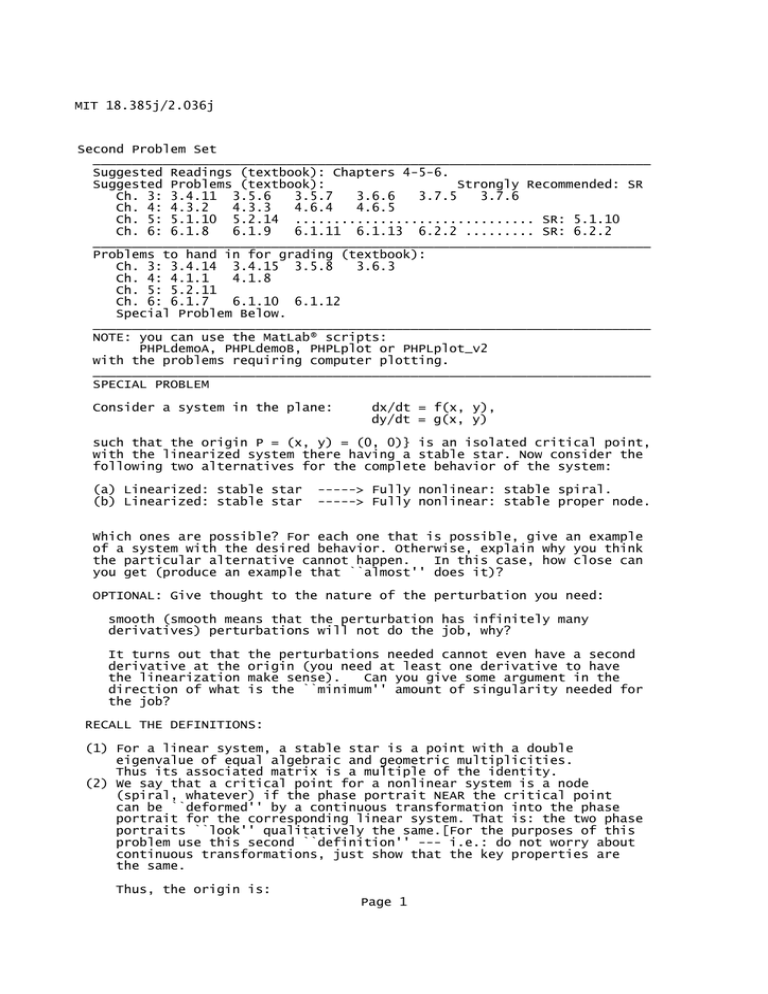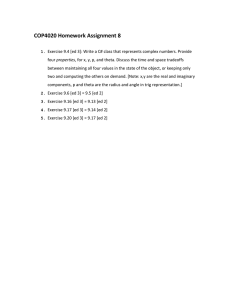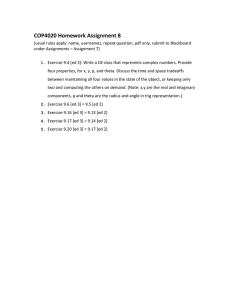MIT 18.385j/2.036j Second Problem Set ________________________________________________________________________
advertisement

MIT 18.385j/2.036j Second Problem Set ________________________________________________________________________ Suggested Readings (textbook): Chapters 4-5-6. Suggested Problems (textbook): Strongly Recommended: SR Ch. 3: 3.4.11 3.5.6 3.5.7 3.6.6 3.7.5 3.7.6 Ch. 4: 4.3.2 4.3.3 4.6.4 4.6.5 Ch. 5: 5.1.10 5.2.14 ............................... SR: 5.1.10 Ch. 6: 6.1.8 6.1.9 6.1.11 6.1.13 6.2.2 ......... SR: 6.2.2 ________________________________________________________________________ Problems to hand in for grading (textbook): Ch. 3: 3.4.14 3.4.15 3.5.8 3.6.3 Ch. 4: 4.1.1 4.1.8 Ch. 5: 5.2.11 Ch. 6: 6.1.7 6.1.10 6.1.12 Special Problem Below. ________________________________________________________________________ NOTE: you can use the MatLab® scripts: PHPLdemoA, PHPLdemoB, PHPLplot or PHPLplot_v2 with the problems requiring computer plotting. ________________________________________________________________________ SPECIAL PROBLEM Consider a system in the plane: dx/dt = f(x, y), dy/dt = g(x, y) such that the origin P = (x, y) = (0, 0)} is an isolated critical point, with the linearized system there having a stable star. Now consider the following two alternatives for the complete behavior of the system: (a) Linearized: stable star (b) Linearized: stable star -----> Fully nonlinear: stable spiral. -----> Fully nonlinear: stable proper node. Which ones are possible? For each one that is possible, give an example of a system with the desired behavior. Otherwise, explain why you think the particular alternative cannot happen. In this case, how close can you get (produce an example that ``almost'' does it)? OPTIONAL: Give thought to the nature of the perturbation you need: smooth (smooth means that the perturbation has infinitely many derivatives) perturbations will not do the job, why? It turns out that derivative at the the linearization direction of what the job? the perturbations needed cannot even have a second origin (you need at least one derivative to have make sense). Can you give some argument in the is the ``minimum'' amount of singularity needed for RECALL THE DEFINITIONS: (1) For a linear system, a stable star is a point with a double eigenvalue of equal algebraic and geometric multiplicities. Thus its associated matrix is a multiple of the identity. (2) We say that a critical point for a nonlinear system is a node (spiral, whatever) if the phase portrait NEAR the critical point can be ``deformed'' by a continuous transformation into the phase portrait for the corresponding linear system. That is: the two phase portraits ``look'' qualitatively the same.[For the purposes of this problem use this second ``definition'' --- i.e.: do not worry about continuous transformations, just show that the key properties are the same. Thus, the origin is: Page 1 (I) A (stable) spiral point if the orbits near the origin satisfy: r ---> 0 and \theta ---> infinity (or \theta ---> -infinity) as t ---> infinity. (II) A (stable) proper node} if all the orbits near the origin approach it as t ---> infinity, and there are two special directions theta = +/- theta_1 and theta = +/- theta_2 such that: --- There is exactly one orbit such that theta ---> + theta_1 as t ---> infinity. --- There is exactly one orbit such that theta ---> - theta_1 as t ---> infinity. --- For all other orbits: As t ---> infinity, either theta ---> + theta_2, or theta ---> - theta_2. HINT: Consider first small linear perturbations to a linear systems that cause the appropriate changes. Then write systems where perturbations of the same form are introduced by a nonlinearity. The nonlinearity will have to be small, so that it vanishes faster than the linear terms as the origin is approached; but do not make it vanish too fast, else it will not do the job! In fact, you should find that it must vanish so "slowly", that the resulting function has second derivatives that "blow up" at the origin. MATLAB® is a trademark of The MathWorks, Inc. Page 2




